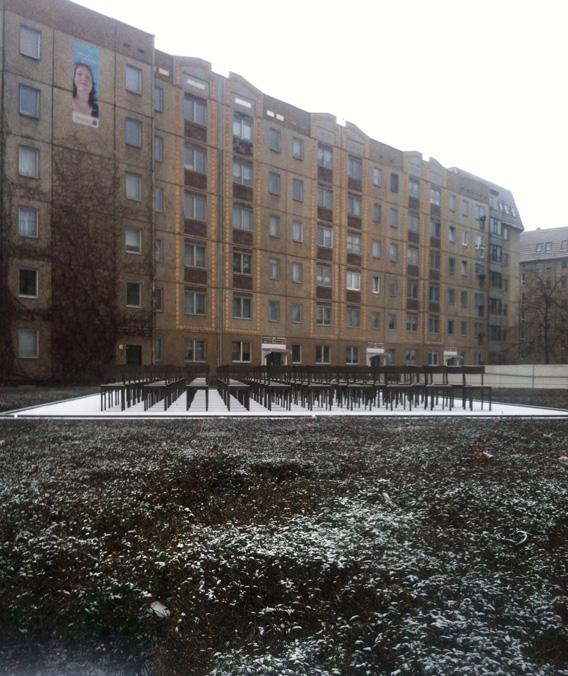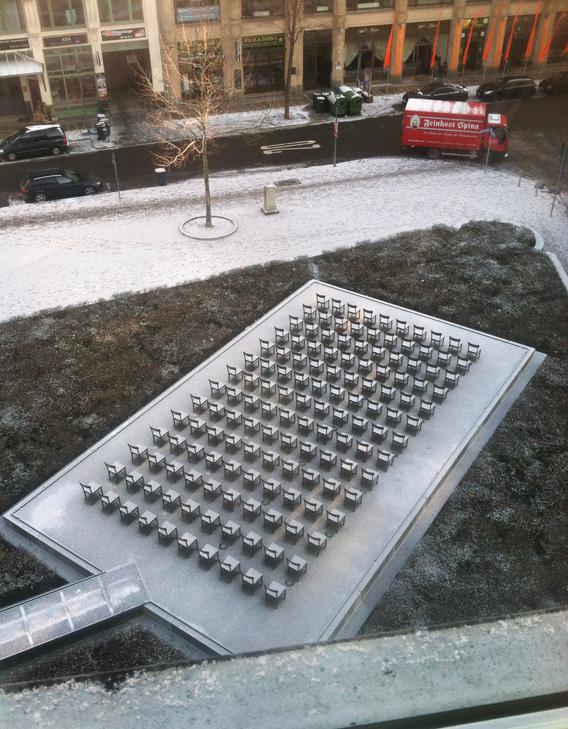I remember sitting with my back to the window. This was mostly because the Wi-Fi in the Leipzig, Germany, apartment I was renting wasn’t great and I needed to use the Ethernet cable, which forced me to sit that way. But whenever I took a break, I would go to look out the window. The blinds were broken, but I would peek through to check on the 140 empty chairs on a raised platform six floors below. The chairs represent the 14,000 Jews who once prayed in this spot. On Nov. 9, 1938, their synagogue was destroyed and in the following years the community was rounded up and decimated by the Nazis.
Like many Jews of my generation, my relationship to the Holocaust is one of remembering, one of learning about the past as a precaution. Though I’m too far removed to have experienced anything firsthand, or even secondhand, as many children of survivors have, I’ve been told about the Holocaust so many times—through school plays, camp activities, heritage trips to Poland, some of my favorite YA novels—that I’ve internalized it; it’s come to feel like a shared memory even though I was spared the trauma. The title story in Nathan Englander’s latest collection, What We Talk About When We Talk About Anne Frank, captures the culture of this transferred memory, describing a curiously popular game in which Jews try to figure out which of their neighbors would hide them should the Nazis threaten us again. In one sense, the game plays on Jewish paranoia, but it also taps into this idea of transferred memory. Never having had to hide ourselves, we imagine what it would be like if we did.
I’ve been thinking about that game, and about those chairs, a lot today. Yesterday began the eight-day period designated by the U.S. Congress as Days of Remembrance of the Victims of the Holocaust, which coincides each year with the Israeli day of Holocaust remembrance: Yom HaShoah. These events prompt Jews and gentiles alike to remember the Holocaust—and to consider the best way for memorializing it, a question made that much more pressing as the last of those who survived it disappear.
Earlier this year, I spent a few months living in Germany, where reminders of the Holocaust are around every corner. Every time someone asked me why I was making the trip, I gave a different answer. My Jewish day-school education had taught me to fear Germany, but I fell in love with what the country has become during a visit in my college years. In an attempt to reconcile the two ideas of the place, I boarded a plane. I kept my job and worked New York hours (4-12 p.m. German time) and spent the days learning the cities I visited—I spent my first six weeks in Berlin—and exploring converted post offices, bunkers, and factories all turned into various art spaces. I ate in more than one vegan restaurant that doubled as a secondhand clothing store. I went to bookstores to hear experimental jazz and abandoned buildings to see opera scenes from Faust performed before a packed screening of Mephisto followed by, of course, a rave.
Each Saturday morning I would go to synagogue services, not always the same one: There was the Synagoge Oranienburger Strasse, a rebuilt dome that is an iconic part of the Berlin skyline; Synagoge Rykestrasse, which was not totally damaged during Kristallnacht and was the only active synagogue during the GDR; and the Lauder community in Berlin. I loved participating in the small but lively Berlin Jewish community. It felt like an assertion of power and pride—the ability to be a Jew doing Jewish things in a country where that had been impossible only a few decades earlier.
But I wasn’t really going out of my way to do Jewish things in Berlin—I always pray on Saturday morning. Nor was I going out of my way to do Holocaust things—they were impossible to avoid, even if I wanted to. The streets are lined with the Stolperstein—the ever-present Gunter Demnig-designed cobblestone-sized memorials on the ground in front of the homes of every Jew who was deported. The only thing I did steer clear of was the Jewish Museum. On my previous visit to Berlin, I had made the trip to the museum, already a bit skeptical. I have a conflicted relationship with Jewish museums that display the “history” of the Jews; they remind me of the Museum for the Extinct Race that Hitler had proposed (this feeling was solidified on a visit to Prague, which made me feel like my traditions and customs were for a vestige of an extinct race). I didn’t go back.

Photo by Miriam Krule
I did begin to frequent the Memorial to the Murdered Jews of Europe, though—it was unavoidable, purposely so, right near the Brandenburg Gate. Many people have been highly critical of the design—2,711 gray concrete stelae—for its lack of specificity (which murdered Jews are being remembered?) and clarity (are these headstones? Sarcophagi?). But I think the ambiguity, which really isn’t ambiguous at all, is what makes the memorial so successful. I understand that assuming everyone knows something is the path to everyone forgetting it, but I don’t think the main purpose of a Holocaust memorial is to educate the viewer. I was drawn to the memorial more for what it left unsaid. I appreciated its abstractness, and how quickly you comprehend its meaning without explanation. I appreciated its immensity and its precision and organization, which brings to mind not just the Holocaust’s victims but its brutally efficient perpetrators.
For a while the memorial was my favorite Holocaust memorial, if one can use such a word in this context, but that was before I traveled to Leipzig. The apartment I was renting was built on the footprint of the city’s main synagogue, which was burnt to the ground during Kristallnacht. The 140 empty chairs—14 neat rows of 10—serve as a memorial for the 14,000 Leipzig Jews who lost their lives at the hands of the “Facists,” as the plaque along the far wall explains in Hebrew and German and English (and, I was surprised to find out, Braille).
I didn’t know about the memorial, or the location of the synagogue, when I found the apartment on AirB&B. I lugged my suitcase from the train station and arrived at my building, looking up from the map on my phone, to a raised platform with 140 chairs. If I saw such an installation in New York, I’d think it was public art—but here, I knew what it was before I saw the plaque.
The Leipzig memorial reminded me of a different, perhaps more subtle, memorial in a small park in Berlin, with an overturned chair and a large table, capturing the moment when the Gestapo grabbed Jews from their homes. (It’s also similar to the Oklahoma City memorial.) The memorial itself is striking in its conspicuousness, but what moved me most was its unexpectedness. It was integrated into the urban landscape, across the street from cafés and even a club and adjacent to my apartment building. Its location directly correlated to its message, but a reborn city had risen around it.
Nothing can replace education about what happened to this congregation, and nothing should. These congressionally appointed days, and Israel’s holiday, are important prompts to remember, and study, the Holocaust. But memorials, like the one in Leipzig, can have more emotional resonance than a textbook. They capture your attention, force you to think. And the best ones—to me, at least—force you to relate to them without instruction, because instructing isn’t their job. The 140 chairs outside my apartment were beautiful, which makes them all the more powerful. They’re something I will never forget.
